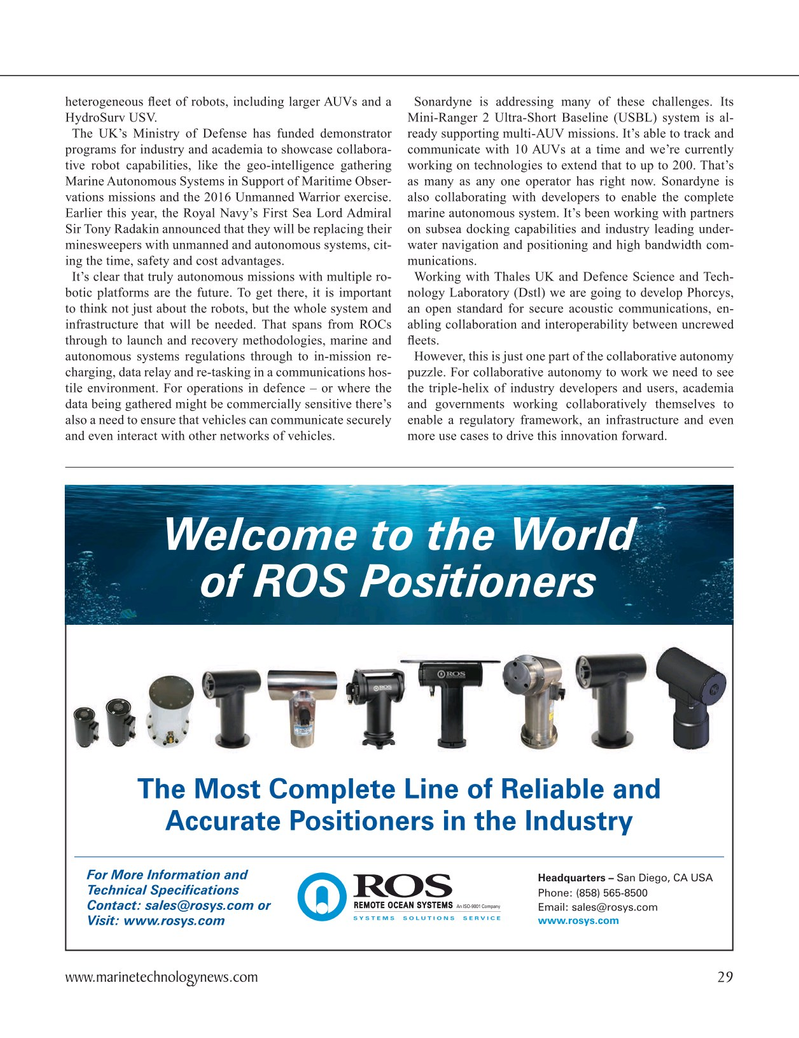
Page 29: of Marine Technology Magazine (September 2021)
MTR100: Focus on 100 Leading Companies, People and Innovations in the Subsea Space
Read this page in Pdf, Flash or Html5 edition of September 2021 Marine Technology Magazine
heterogeneous ? eet of robots, including larger AUVs and a Sonardyne is addressing many of these challenges. Its
HydroSurv USV. Mini-Ranger 2 Ultra-Short Baseline (USBL) system is al-
The UK’s Ministry of Defense has funded demonstrator ready supporting multi-AUV missions. It’s able to track and programs for industry and academia to showcase collabora- communicate with 10 AUVs at a time and we’re currently tive robot capabilities, like the geo-intelligence gathering working on technologies to extend that to up to 200. That’s
Marine Autonomous Systems in Support of Maritime Obser- as many as any one operator has right now. Sonardyne is vations missions and the 2016 Unmanned Warrior exercise. also collaborating with developers to enable the complete
Earlier this year, the Royal Navy’s First Sea Lord Admiral marine autonomous system. It’s been working with partners
Sir Tony Radakin announced that they will be replacing their on subsea docking capabilities and industry leading under- minesweepers with unmanned and autonomous systems, cit- water navigation and positioning and high bandwidth com- ing the time, safety and cost advantages. munications.
It’s clear that truly autonomous missions with multiple ro- Working with Thales UK and Defence Science and Tech- botic platforms are the future. To get there, it is important nology Laboratory (Dstl) we are going to develop Phorcys, to think not just about the robots, but the whole system and an open standard for secure acoustic communications, en- infrastructure that will be needed. That spans from ROCs abling collaboration and interoperability between uncrewed through to launch and recovery methodologies, marine and ? eets. autonomous systems regulations through to in-mission re- However, this is just one part of the collaborative autonomy charging, data relay and re-tasking in a communications hos- puzzle. For collaborative autonomy to work we need to see tile environment. For operations in defence – or where the the triple-helix of industry developers and users, academia data being gathered might be commercially sensitive there’s and governments working collaboratively themselves to also a need to ensure that vehicles can communicate securely enable a regulatory framework, an infrastructure and even and even interact with other networks of vehicles. more use cases to drive this innovation forward.
:HOFRPHWRWKH:RUOG
RI5263RVLWLRQHUV 7KH0RVW&RPSOHWH/LQHRI5HOLDEOHDQG $FFXUDWH3RVLWLRQHUVLQWKH,QGXVWU\ )RU0RUH,QIRUPDWLRQDQG +HDGTXDUWHUV²6DQ'LHJR&$86$ 7HFKQLFDO6SHFLILFDWLRQV 3KRQH &RQWDFWVDOHV#URV\VFRPRU (PDLOVDOHV#URV\VFRP
ZZZURV\VFRP 9LVLWZZZURV\VFRP www.marinetechnologynews.com 29
MTR #7 (18-33).indd 29 9/21/2021 3:47:32 PM

 28
28

 30
30
